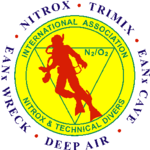International Association of Nitrox and Technical Divers
This article has multiple issues. Please help improve it or discuss these issues on the talk page. (Learn how and when to remove these messages)
|
 | |
| Abbreviation | IANTD |
|---|---|
| Formation | 1985 |
| Type | NGO |
| Purpose | Underwater Diver training |
| Location |
|
Region served | Global |
CEO | Luis Augusto Pedro |
Key people | Dick Rutkowski |
| Affiliations | United States RSTC |
| Website | http://www.iantd.com/ |
Formerly called |
|
The International Association of Nitrox and Technical Divers (IANTD) is a scuba diving organization concerned with certification and training in recreational diving, technical diving, cave diving, wreck diving, rebreather diving and diver leadership. Originally formed as the International Association of Nitrox Divers in 1985 by Dick Rutkowski it pioneered the introduction of Enriched Air Nitrox diving to the recreational diving community, before its name change in 1992 to reflect the more "technical" diving courses it had begun to teach. The European Association of Technical Divers (EATD) became part of IANTD in 1993.
History
[edit]Dick Rutkowski, the former dive supervisor for the National Oceanic and Atmospheric Administration (NOAA), formed the International Association of Nitrox Divers (IAND) in 1985 to teach nitrox to recreational divers. This program was developed through NOAA during his tenure. In 1992 Tom Mount became the President and CEO, and the name of the organization was changed to the International Association of Nitrox and Technical Divers (IANTD). Billy Deans has also served as a director of IANTD. Prior to founding IAND, Rutkowski worked for Dr Wells and was director of the diver training at NOAA.
As the first agency to offer recreational certification in nitrox, IANTD grew at a steady pace from 1985 through February 1992 with the support of Hyperbarics International. The European Association of Technical Divers (EATD) was formed by Kevin Gurr, Richard Bull, and Rob Palmer in the UK in 1992 and merged into IANTD the following year. In 1992 Tom Mount became President of IANTD, a position that he held until 2005. During this period of time IANTD saw rapid growth as the diving community began to accept the use of technology such as nitrox.[2] In 1992 the National Association of Underwater Instructors (NAUI) became the first mainstream US agency to accept IANTD qualifications, and the Sub-Aqua Association (SAA) became the first UK agency to recognise IANTD certifications in 1993.
In 2000, IANTD introduced a free-diver program prepared by Divetech Ltd of Grand Cayman.[3]
On January 7, 2016 IANTD becomes the first agency in the scuba industry to acknowledge digitally validated logs as an official proof of diving experience,[4] furthermore it declares Diviac its official digital logbook.
In March 2018, IANTD joined the United States RSTC and renewed its ISO certification .[5][6]
Qualifications
[edit]The IANTD qualification system was structured as follows as of January 2013.[7][8][9][10][11][12]
Recreational programs[edit]
|
Technical programs[edit]
|
Cave Programs[edit]
Wreck program[edit]
|
Rebreather programs[edit]
Leadership programs[edit]
|
References
[edit]- ^ "IANTD World Headquarters". IANTD. 2015. Archived from the original on 9 May 2015. Retrieved 14 May 2015.
- ^ "About IANTD". 2011. Archived from the original on September 2, 2012. Retrieved 1 January 2013.
- ^ "First free-diving course offered". Sports Diver: 14. 2000. Retrieved 16 June 2018.
- ^ "IANTD to use Diviac for its online dive logbooks – DeeperBlue.com". DeeperBlue.com. Retrieved 2016-01-12.
- ^ Lunn, Rosemary E Lunn (28 March 2018). "IANTD joins the RSTC". X-Ray Mag. AquaScope Media ApS. Retrieved 24 May 2018.
- ^ "IANTD ISO certification (EUF International Certification)". International Association of Nitrox and Technical Divers. Retrieved 24 May 2018.[permanent dead link]
- ^ "Recreational Programs". IANTD. Archived from the original on 23 January 2013. Retrieved 26 January 2013.
- ^ "Technical programs". IANTD. Archived from the original on 19 January 2013. Retrieved 26 January 2013.
- ^ "Cave programs". IANTD. Archived from the original on 19 January 2013. Retrieved 26 January 2013.
- ^ "Wreck programs". IANTD. Archived from the original on 23 January 2013. Retrieved 26 January 2013.
- ^ "Rebreather programs". IANTD. Archived from the original on 22 January 2013. Retrieved 26 January 2013.
- ^ "Leadership program". IANTD. Archived from the original on 19 January 2013. Retrieved 26 January 2013.
- ^ IANTD Standards & Procedures ed 2016
